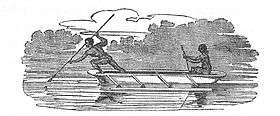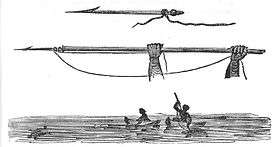Guugu Yimithirr
- This article is for the Indigenous Australian group. For their language, see Guugu Yimithirr language.
 Location of the Guugu Yimithirr people |
The Guugu Yimithirr are an Australian Aboriginal tribe of Far North Queensland, many of whom today live at Hopevale (population approximately 800), which is the administrative centre of Hopevale Shire. It is about 46 km from Cooktown by road. It is also the name of their language. They were a coastal people and refer to themselves as a "saltwater people."
European interest


Sydney Parkinson, who arrived with Lt. James Cook at the mouth of the Endeavour River at the site of modern Cooktown, on 11 June 1770 after their boat, the HM Bark Endeavour was damaged on a reef, described the local people:
- "The natives, who were naked, though of a diminutive size, ran very swiftly, and were very merry and facetious. Their bones were so small, that I could more than span their ancles; and their arms too, above the elbow joint. The tallest we saw measured but five feet nine inches; though their slimness made them appear taller, most of them were about five feet five inches; and were painted with red and white in various figures. The colour of their skin was like that of wood-soot. They had flattish noses, moderate-sized mouths, regular well-set large teeth, tinged with yellow. Most of them had cut off the hair from their heads; but some of them wore their hair, which was curled and bushy, and their beards frizzled. On their breasts and hips were corresponding marks like ridges, or seams, raised above the rest of the flesh, which looked like the cicatrices of ill-healed wounds. Some of them were painted with red streaks across the body, and others streaked over the face with white, which they called Carbanda. Some of them had a small hair-rope about their loins, and one about an arm, made of human hair. They had also a bag that hung by their necks, which they carried shell-fish in. Their noses had holes bored in them, through which they drew a piece of white bone about three or five inches long, and two round. One of them had his ears bored in like manner, and pieces of bone hung in them. Some of them had necklaces made of oval pieces of bright shells, which lay imbricated over one another, and linked together by two strings. The women, who did not approach nearer to us than the opposite shore, had feathers stuck on the crown of their heads, fastened, as we were informed, to a piece of gum.
- They had lances and levers, very neatly made of a reddish wood; and had two pieces of bone, joined together with pitch, that stood out at the end of them. To polish their lances they made use of the ficus riduola, which served the pur-pose of a rasp. Their canoes were made out of the trunks of trees; had an out-rigger; and eight outriggers on which they laid their lances. Their paddles were long in the blade. To throw the water out of their canoes, they used a large shell called the Persian-crown.
- Their language was not harsh, as may be seen by the following vocabulary, and they articulated their words very distinctly, though, in speaking, they made a great motion with their lips, and uttered their words vociferously, especially when they meant to shew their dissent or disapprobation. When they were pleased, and would manifest approbation, they said Hee, with a long flexion of the voice, in a high and shrill tone. They often said Tut, tut, many times together, but we knew not what they meant by it, unless it was intended to express astonishment. At the end of this Tut, they sometimes added Urr, and often whistled when they were surprised."[1][2]
Focus for European missionaries
In 1885, while delayed on his journey to Kaiser-Wilhelmsland (German New Guinea), the Lutheran missionary Johann Flierl founded Elim Aboriginal Mission, Queensland at Cooktown, which was later known as Hope Vale.
See also
Footnotes
References
- gangurru. (1986). Howard J. Polner. Assembly Press, Slack Creek, Queensland. ISBN 1-86252-311-8.
External links
- Bibliography of Guugu Yimidhirr people and language resources, at the Australian Institute of Aboriginal and Torres Strait Islander Studies